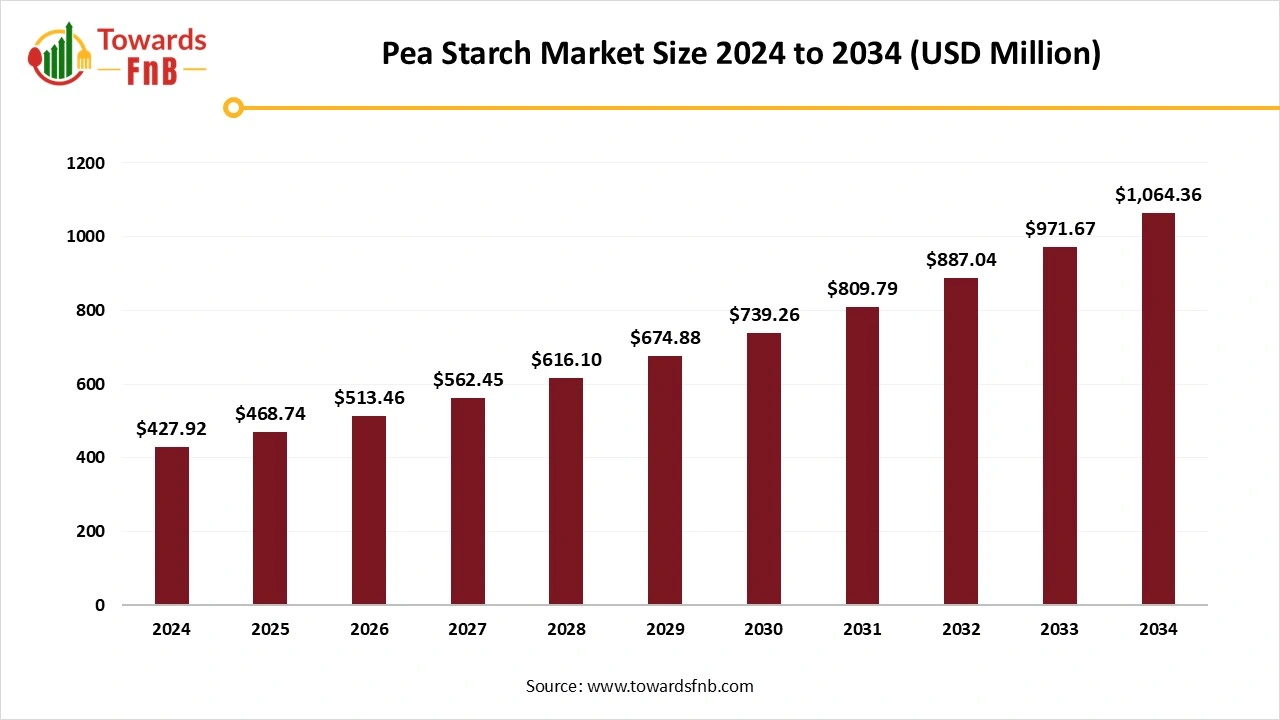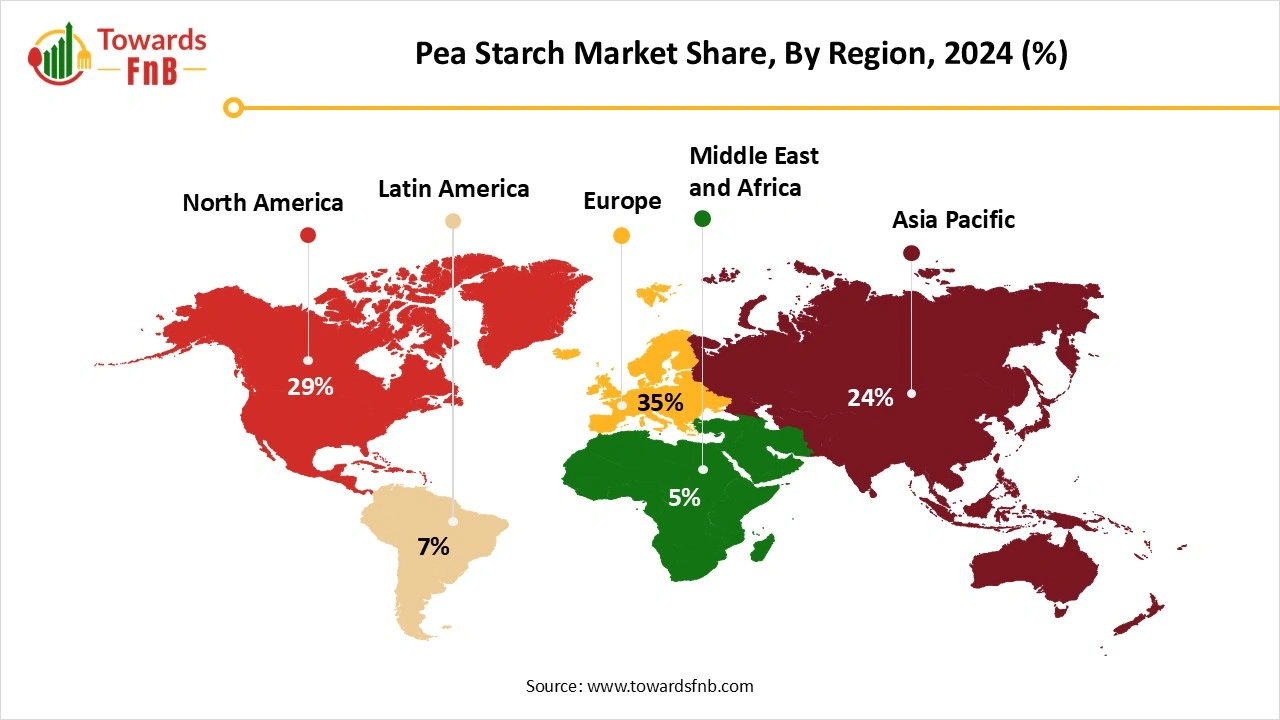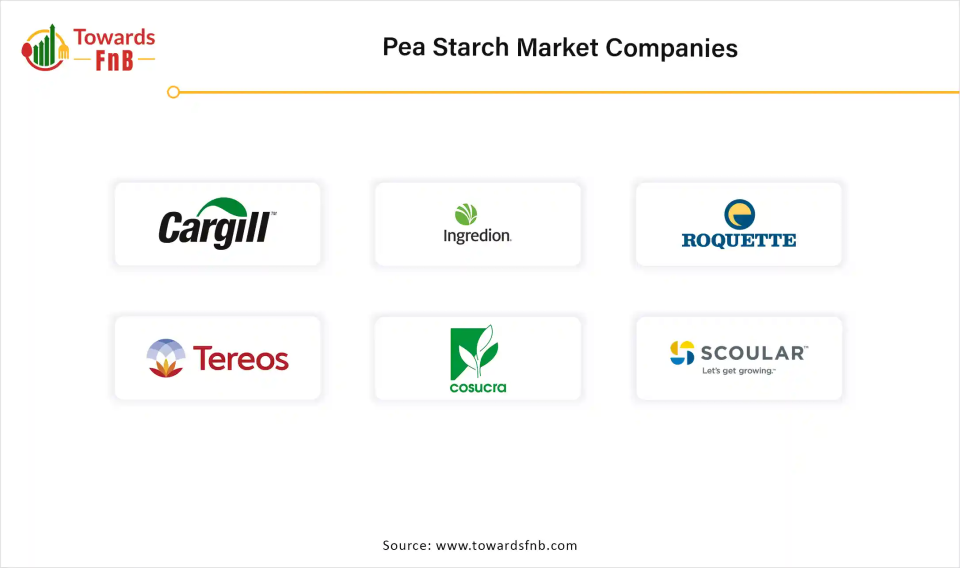December 2025
The global pea starch market size was calculated at USD 427.92 million in 2024 with projections indicating a rise from USD 468.74 million in 2025 to approximately USD 1,064.36 million by 2034, expanding at a CAGR of 9.54% throughout the forecast period from 2025 to 2034. The rising demand for gluten-free products among consumers is due to the increase in gluten intolerance and celiac disease that boosts the growth of the market.

| Study Coverage | Details |
| Growth Rate from 2025 to 2034 | CAGR of 9.54% |
| Market Size in 2025 | USD 468.74 Million |
| Market Size in 2026 | USD 513.46 Million |
| Market Size by 2034 | USD 1,064.36 Million |
| Largest Market | Europe |
| Base Year | 2024 |
| Forecast Period | 2025 to 2034 |
| Regions Covered | North America, Europe, Asia-Pacific, Latin America, and Middle East & Africa |
Pea starch market deals with carbohydrate derived from yellow peas, commonly used in a variety of applications including food & beverages, textiles, pharmaceuticals, and more. Known for its high resistance to heat and moisture, it is increasingly used as a gluten-free and non-GMO alternative to traditional starches. Pea starch is also valued for its clean-label attributes, making it a popular choice among consumers looking for natural and sustainable ingredients.
Some of the major growth factors driving the growth of the market, such as increasing demand for clean-label and plant-based products, rising demand from the food and beverage industry, and growing pet industry. Various consumers are becoming more environmentally conscious and health aware. The pea starch is non-GMO and gluten-free and make it appropriate ingredient clean-label and gluten-free products. In addition, pea starch can improve the taste and texture in bakery items, snacks, soups, sauces, dairy alternatives and more. These factors are expected to fuel the growth of the market.
One of the major significant opportunities revolutionizing the market growth is the increasing focus on reduction of plastic and sustainability. Pea starch serves as a valuable additive to develop biodegradable single-use items, wrappers, bags and films, due to non-toxic, compostable and renewable properties. In addition, the demand for starch-based bioplastics is increasing rapidly with increased government strict regulations on eco-friendly businesses and single-use plastics, which may create major opportunities in the global market. In addition, innovation in modified pea starch applications and expansion in sports and functional food are further expected to revolutionize the growth of the pea starch market in the coming years.
One of the major challenging factors hindering the market growth is the increasing fluctuations in raw material supply. Pea starch production heavily based on raw peas and steadily supply. Leading to price volatility and shortages, the increasing fluctuation in pea harvests due to diseases, pests, and weather conditions can disturb the supply chain may create challenges. These factors are expected to restrain the growth of the pea starch market.
How Europe Dominates the Global Market Revenue in 2024?
Europe dominated the market revenue in 2024. The market growth in the region is attributed to the various growth factors such as the increasing consumer preference towards eco-friendly and natural ingredients, increasing presence on non-GMO and organic certifications, increasing adoption of pea starch, increasing consumer preference towards clean-label and sustainable agriculture products, and increasing government initiatives. Germany, France and UK are dominating countries fueling the market growth in the region.

Germany dominated the pea starch market revenue in 2024, driven by increasing influence of fitness and sports trends, increasing demand for functional and natural ingredient, and increasing focus on wellness and health. Germany created a German sales market for peas and foster the cultivation of peas in Germany. Pea starch is gaining popularity in the personal care and cosmetics due to hypoallergenic, thickening and oil-absorbing properties, which further drives the market growth in Germany.
Asia Pacific Pea Starch Market Trends
Asia Pacific is expected to grow fastest in the market during the forecast period. The market growth in the region is driven by factors such as rising research and development activities to improve functionality, increasing demand for pea starch in processed food products, increasing consumer preference towards heathier alternatives and convenience food, increasing disposable incomes and growing urbanization. China, India, Japan and South Korea are the fastest growing countries boosting the market growth. India is expected to grow fastest during the forecast period. Over 20 countries, India imports pea starch across the globe.
How Yellow Peas Segment Dominates the Pea Starch Market Revenue in 2024?
The yellow peas segment dominated the pea starch market revenue in 2024. The segment growth in the global market is attributed to the various benefits such as high in protein, source of soluble fibre, nutritionally dense with minerals and vitamins B, good source of carbohydrates, and powerful antioxidant. As a powerful antioxidant, yellow peas offer protection of oxidative stress on the body. The yellow peas are great at promoting satiety and keeping blood sugar levels. Yellow peas help consumers to feel fuller and reduce constipation. They are a great source of iron and contain high-quality protein, which may enhance consumer health and wellness and further drives the segment growth.
The Green Peas Segment is Expected to Grow Fastest During the Forecast Period.
The segment growth in the market is attributed to the various health benefits, such as weight management, blood sugar regulation, heart health and improved digestion. Green peas are a rich source of minerals, vitamins, fiber and protein. They help to reduce the prevalence of chronic diseases and help to protect against inflammation and oxidative stress, further expected to drive the segment growth.
Why Native Pea Starch Segment Held the Largest Pea Starch Market Revenue in 2024?
The native pea starch segment dominated the pea starch market revenue in 2024. The native pea starch plays an important role in the pea starch industry. Consumers are seeking for food with great texture and taste made with clean label and recognizable ingredients. Without sacrificing color or taste, manufacturers gain a great option with native pea starches. Native pea starch provides functionality benefits and key performance in a huge range of applications such as replacing gelatin in jelly and gummy confectioner, grain-free texturizing in gluten-free bakery products and anti-caking for shredded cheese. This native pea starch helps in supporting brand’s sustainability image, reducing resource use and enhance overall health, which expected to drive the segment growth.
The Modified Pea Starch Segment is Expected to Grow Fastest During the Forecast Period.
The modified pea starch is a necessary ingredient that enhances the functionality of food and beverage applications and performance. Modified pea starch is ideal for products that need to improve processing conditions like shear, acidity or heat by offering precise texture control, enhanced thickening and improved stability. Modifies pea starch delivers reliable and consistent results that improve product shelf life and quality from sauces to dressings to baked products and frozen meals. This starch is budget-friendly for consumers and ideal for dairy products and high temperatures, which may drive the segment growth.
What Factors Help Food & Beverages Segment Grow in 2024?
The food and beverages segment dominated the pea starch market revenue in 2024. The segment growth in the global market is attributed to the factors such as increasing demand for natural food additives, increasing consumer preference towards clean-label and organic food ingredients, increasing demand of protein isolates and concentrates from pea, and increasing interest of plant-based. In the food and beverage, the application of starch is determined especially by thermal and physical properties which depends on the molecular architecture and purity of the starches. Pea starch is widely used to bind water and stabilizing and thickening agent in the food and beverage industry, contributed to propel the market growth.
The Biodegradable Plastics Segment is Expected to Grow Fastest During the Forecast Period.
The segment growth in the market is drive by various benefits such as eco-friendly and sustainable impact, reduced pollution, biodegradability, enhancing properties and cost-effectiveness. The biodegradable plastics meeting environmental concerns related to pollution and plastic waste due to its sustainable alternative plastics. In addition, pea starch-based plastics can be modified to improve their properties and offer potential for minimizing landfill space, which is further expected to accelerate the market growth.
How Powdered Pea Starch Segment Dominates the Pea Starch Market Revenue in 2024?
The powdered pea starch segment dominated the market revenue in 2024. Powdered pea starch includes major properties such as stabilizing, gelling and thickening and offering a smooth mouthfeel. It is also use for making crispy textures, anti-caking agent and fat substitute. Powdered pea starch improving the stability and texture of food products and helps to prevent ingredients from separating. It is ideal for organic and clean label products as it has non-allergic and non-GMO ingredient, which expected to drive the segment growth in the global market.
The Liquid Pea Starch Segment is Expected to Grow Fastest During the Forecast Period.
The segment growth in the pea starch market is driven by improve stability and enhance texture and enhance nutritional profiles. Food manufacturers seeking pea starch to address the increasing demand for sustainable and healthier products. Manufacturers adopt premium products that enhance end products and production processes with a focus on consistency and reliability, which further expected to transform the segment demand in the global market.
Why Binding Agent Segment Dominates the Pea Starch Market Revenue in 2024?
The binding agent dominated the market revenue in 2024. The binding agent improving yield, juiciness and texture and act as a moisture-retaining and binder agent. It helps to reduce syneresis and enhances firmness and make it ideal for burgers, sausages and other reformed seafood and meats-based formulations. In addition, there are various benefits related to binding agent such as enhances color and neutral taste, plant-based and clean-label alternatives, heat and shear stability, improves crispiness and improves dough elasticity, which further drives the segment growth.
The Thickening Agent Segment is Expected to Grow Fastest During the Forecast Period.
Pea starch is a sustainable and versatile choice for a wide range of food applications, with its ability to enhance texture, moisture retention and thickening. Thickening agents provides a smooth texture in dairy alternatives, sauces and soups and enhances viscosity. Pea starch ensures a stable and smooth consistency in pie fillings as a thickening agent. These factors are expected to accelerate the demand for thickening agent in the global market.
What Factors Help Food Industry Grow in 2024?
The food industry dominated the pea starch market revenue in 2024. The market growth in the global market is attributed to the factors such as increasing consumer preference towards clean label products, increasing rapid growth in soups & sauces, dairy alternatives and bakery products and increasing demand for gluten-free and plant-based food.
The Biodegradable Plastics Segment is Expected to Grow Fastest During the Forecast Period.
The segment growth in the pea starch market is drive by various benefits such as eco-friendly and sustainable impact, reduced pollution, biodegradability, enhancing properties and cost-effectiveness. The biodegradable plastics meeting environmental concerns related to pollution and plastic waste due to its sustainable alternative plastics. In addition, pea starch-based plastics can be modified to improve their properties and offer potential for minimizing landfill space, which is further expected to accelerate the market growth.
Roquette
Ingredion

By Source
By Type
By Application
By Form
By Functionality
By End-User Industry
By Region
December 2025
December 2025
December 2025
December 2025